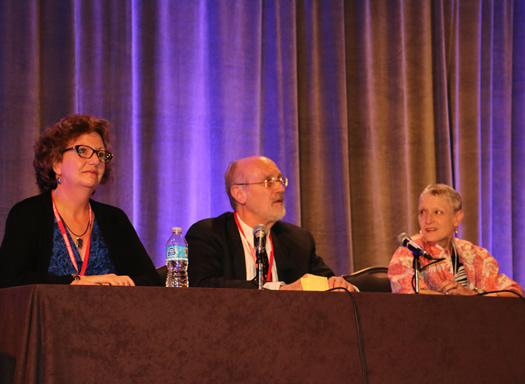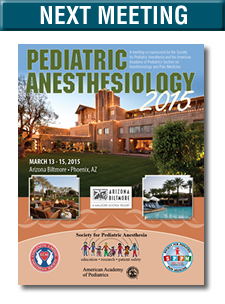SPA Annual Meeting Reviews
Session V: Challenging Patients, Parents and Situations
By Sally E. Rampersad, MB, DCH, FRCA and Iskra Ivanova, MD
Seattle Children’s Hospital
Martin J. Drell, MD (Louisiana State University Health Sciences Center) started his talk, “When Bad Things Happen to Good Kids,” with what he refers to as ‘The Stuff Happens Continuum.’ It begins with normal life stressors and normal developmental crises and transitions to a DSM V (Diagnostic and Statistical Manual) psychiatric disorder (adjustment disorder, acute stress reaction, posttraumatic stress disorder).

Dr. Susan R. Staudt, Dr. Martin J. Drell and Dr. Nancy L. Glass
Normal life stressors may be acute or chronic (with no clear boundary between them) and traumatic. It is important to recognize that all traumatic events are stressors, however not all stressors are traumatic. Issues of loss, change, anxiety, and social adaptation predominate. The Adverse Childhood Experiences (ACE) study (Felitti, 2014) is an ongoing collaborative effort between the Centers for Disease Control and Prevention and Kaiser Permanente, and suggests a correlation between childhood trauma and later social functioning, well being, disease and public health problems, medical costs, and death.
Next, Dr. Drell explained the concept of the developmental biopsychosocial model - what is the child’s developmental stage and functional level? Children at different ages think and understand events differently. There are key developmental sensitivities that are age-specific:
-
Age 3 and under – separation, safety, and disappearance of loved person
-
Age 3-7 – abandonment, punishment, and bodily harm
-
Age 7-13 – loss of control, fear of death
-
Age 13-18 – physical appearance, loss of peer, fear of dependency
Normal developmental crises are universal, predictable stressors that occur in the family cycle, such as marriage, birth of a child, start of school, puberty, children leaving home, parental aging and death. The same developmental biopsychosocial issues apply.
Next, Dr. Drell covered in depth the current understanding, criteria for, and treatment of several important DSM V diagnoses – adjustment disorder, acute stress reaction (a relatively new DSM V diagnosis), and posttraumatic stress disorder (PTSD), including some interesting areas of research in the domain of PTSD – the neurobiologic underpinnings of PTSD, and PTSD and memory reconsolidation.
In conclusion, Dr. Drell emphasized that illness, hospitalization, surgery and anesthesia are stressful at any age. We, as pediatric anesthesiologists, are in a unique position to help reinforce and support positive coping techniques in the child and the family during this stressful time.
Things that may be done and are helpful in this process include:
-
Be sensitive to developmental and biopsychosocial complexities
-
Educate all parties about the illness and expected treatment (have as few surprises as possible)
-
Realize that children can talk about almost anything at their developmental level (be open to talking to children and caregivers)
-
Maintain family, life, and hospital routines as much as possible
-
Consider illness-specific support groups and facilitate access to mental health professionals
-
Treat pain aggressively
In conclusion, this was an interesting talk that left the audience with a greater appreciation of the biopsychosocial model of disease and illness, allowed an in-depth look into a child psychiatrist’s approach to stressful events in children, and offered some suggestions and strategies about how to mitigate the impact of stressful events in children.
Susan Staudt, MD, MSEd (Children’s Hospital of Wisconsin) lecture, “Anesthesia Care Provision Following Conflict with a Colleague or Worse... a Parent,” focused on the difficult topic of conflict. Her interest in this subject began when asked to review a QI case several years ago. The child was having a neuroblastoma resection and had lower extremity intra-venous (iv) access. During the case the surgeon clamped the Inferior Vena Cava (IVC) to control bleeding but told no one that he had done this. Resuscitation continued through the lower extremity iv despite the IVC clamp and the child died. In reviewing the case, Dr. Staudt realized what a huge role communication had played in this terrible outcome. It has been her passion ever since to understand how and why communication fails.
A study by Lingard (Qual Saf Health Care, 2004) studied communication by direct observation and showed that one-third of communications in the operating room (OR) failed and one-third of failed communications jeopardized patient safety. Studies of conflict in the OR demonstrate that it is common and that those involved do not agree as to whether it is present or not. Conflict may be around a process or task, but can also involve relationships eg. criticism in a public forum, team roles and authority, conflicts between the team and a patient or family. Dr. Staudt illustrated her points with some “Oscar-winning” role playing, performed by her colleagues in Wisconsin, of two conflict situations that might arise in the OR.
She next described a tool for analyzing one’s response to conflict, looking at two axes, assertiveness and cooperativeness. The tool describes five styles of conflict resolution and Dr. Staudt described when to use each style: compromise is not always the best answer. In dealing with families she advocated:
-
Being non-judgemental
-
Listening actively
-
Sharing goals and acknowledging feelings
-
Working as a team
-
Apologizing
-
Showing respect
-
Keeping difficult conversations private
-
Involving a third party if needed
This was a very practical “how to” lecture that left the audience with a better understanding of why conflict occurs in our work environment and armed with tools for how to go about seeking resolution.
The SPA 28th Annual Meeting ended with “The Role of the Anesthesiologist in the Care of the Dying Child” by Nancy Glass, MD, MBA, FAAP, (Texas Children’s Hospital) and at the time of her lecture, she was President of SPA (now Immediate Past President).
Dr. Glass noted that when one searches for “anesthesiology and dying child” almost no papers come up, so her advice to us was based upon years of experience, including her work as a pediatric hospice physician for the past three years.
One of her key messages was that all care in these situations should be goal-directed. There are many reasons that dying or hospice patients may come to the OR, but each and every time we should ask how this procedure will benefit the patient and whether it meets their goals for care. Our goal should be to return the child to his/her pre-operative state as soon as we can. We must remember that as this child goes under anesthesia, it may be the last time that the parents see their child alive, so pre-medication, parental presence and great analgesia are all vitally important.
Dr. Glass quoted Leslie Marmon Silko; “I will tell you something about stories . . . They are all we have, you see, all we have to fight off illness and death.” She then used the remarkable stories of two patients, April and Jose, to illustrate her points about goal-directed care. This was a reminder of what it means to be a human being and a physician. We can heal and help, even when we cannot “cure”.
What a powerful message with which to end our meeting. Thank you, Dr. Glass.



